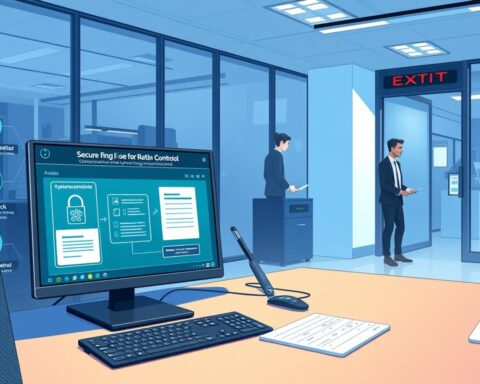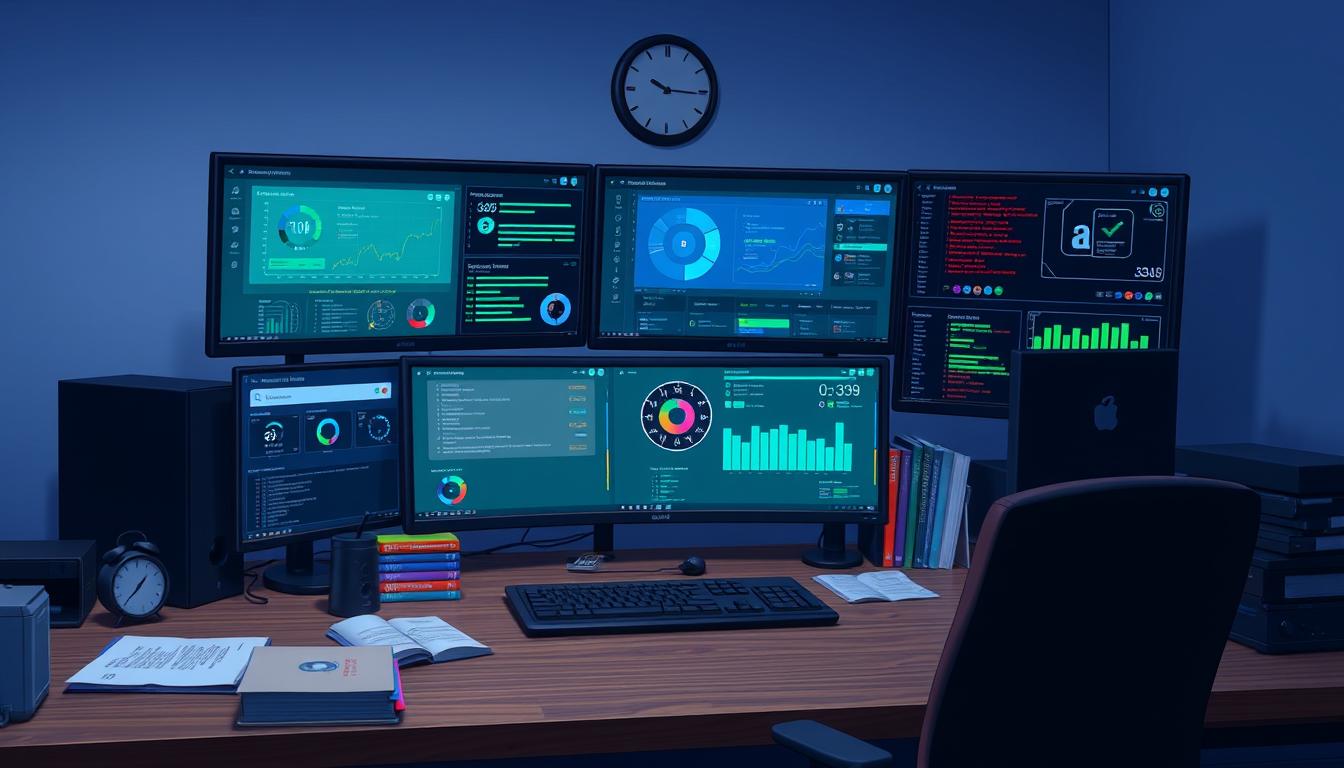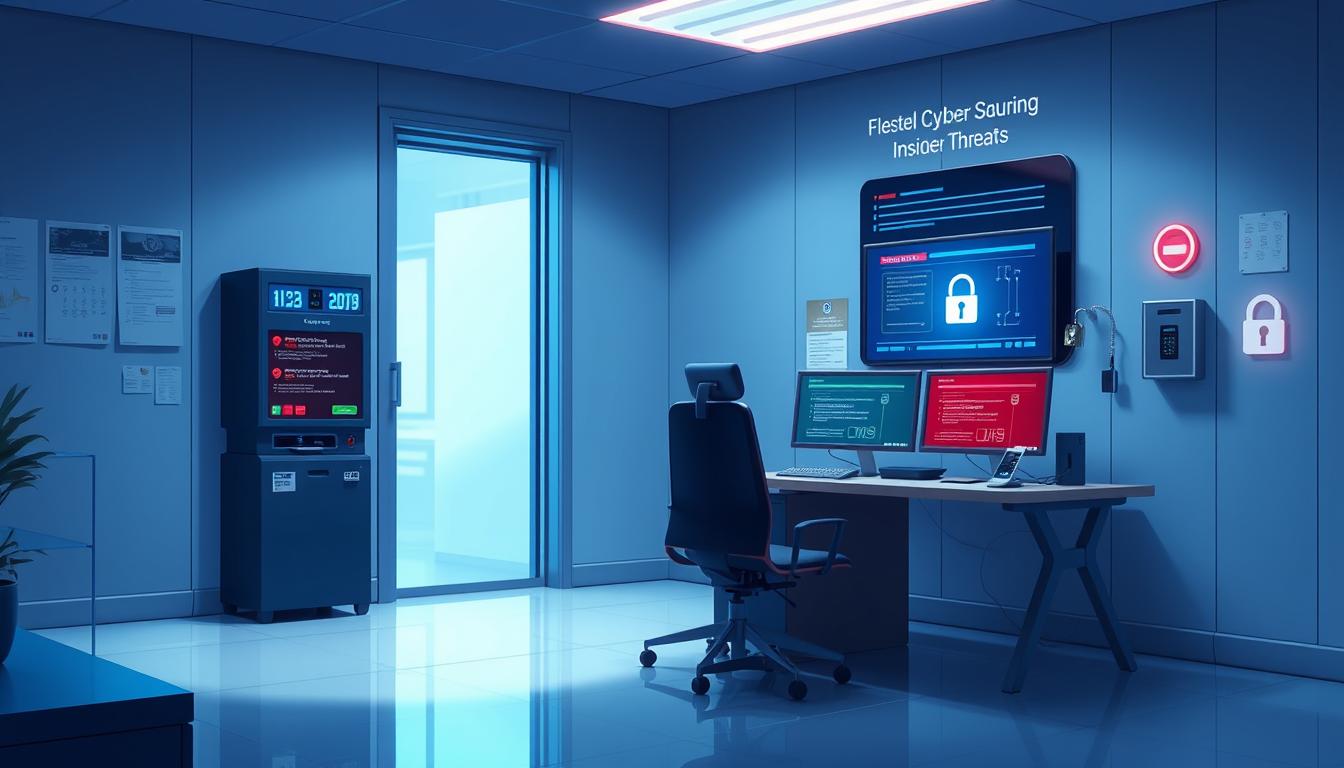Insider threats are a big worry for companies today. About 20% of all data breaches come from insiders, reports say1. It’s key to spot these threats early to stop data breaches and keep info safe. Mixing cybersecurity with business plans helps a lot in keeping risks low2. For more tips, check out cybersecurity tips for both personal and business use.
Knowing what insider threats are is vital for fighting them. Look out for odd network use or data moves that raise flags. Also, watch for changes in how someone acts at work or odd access patterns1.
Key Takeaways
- Insider threats cause about 20% of all data breaches1.
- Spotting insider threats early is key to stopping data breaches and keeping info safe.
- Mixing cybersecurity with business plans helps a lot in keeping risks low2.
- Look out for odd network use or data moves that raise flags to spot threats.
- Watch for changes in how someone acts at work or odd access patterns1.
- Knowing what insider threats are is vital for fighting them.
Understanding the Nature of Insider Threats
It’s vital for companies to spot insider threats to keep their data safe. These threats come from within and can be driven by money, revenge, or not knowing the rules3. Knowing why these threats happen helps in stopping them. To find these risks, a company must look at its weak spots and possible dangers.
There are different kinds of insider threats, like those done on purpose to harm the company, or those that happen by accident4. These threats can really hurt a business, causing money loss, damage to its name, and legal problems. Reasons for these threats include money troubles, being unhappy with the job, or wanting something for themselves3.
Types of Insider Threats
Insider threats can be accidental, malicious, or when someone’s identity is stolen4. Accidental insiders might not mean to, but they do harm data. Malicious insiders do it on purpose. Compromised insiders have their identity stolen. Knowing these types helps in stopping them.
Impact on Organizations
Insider threats can really hurt a company, taking 77 days to fix5. Fixing one for 30 days costs about $7.12 million USD5. Signs like odd access or data moves can show a threat. Spotting these signs is key to stopping threats.
Common Motivating Factors
Reasons for insider threats include money, beliefs, being forced, or being unhappy at work3. Knowing these reasons helps in stopping threats. Companies can fight threats by watching for signs and knowing their weak spots.
The Psychology Behind Malicious Insiders
It’s key to understand why some insiders turn malicious. Factors like stress and job dissatisfaction play a big role6. Studies reveal that stress can build up over 6-12 months, leading to harmful actions7. Once stress gets too much, the decision to harm the company can happen in just 1-2 months7.
Insider threats can be either intentional or unintentional. About 70% of threats are intentional, while 62% are due to careless insiders6. To fight these threats, teaching employees about security and building trust is vital.
Some important facts about insider threats are:
- They cause about 34% of data breaches6
- The cost of an insider threat can be around $11.5 million a year6
- 75% of companies have faced an insider threat in the last year6
By grasping the psychology of malicious insiders and using the right strategies, companies can lower the risk of data breaches8.
Common Signs of Insider Threat Behavior
Organizations face big risks from insider threats. They can spot these threats by watching for common signs. Insider threat indicators show unusual digital signs, changes in behavior, and odd access patterns9. It’s key to watch and analyze employee actions to stop insider threats.
Signs of insider threats include too much document copying, unauthorized downloads, and activity at odd hours10. Also, more access requests can mean a risk to sensitive data11. Spotting these signs helps organizations act fast to check and stop threats. They should use strong monitoring to catch and warn about odd activity, like strange logins or big data moves9.
Tools for watching employees can spot odd behavior, improving by up to 70% when used10. Regular security training can cut insider threat risks by about 50% in trained companies10. Being proactive in finding insider threats helps protect against these dangers.
What Insider Threats Look Like in Different Industries
Insider threats show up in many ways across different fields. In healthcare, they might mean unauthorized access to patient data. This can lead to identity theft and medical fraud12. In finance, they could be the theft of sensitive info like credit card numbers or bank details12.
It’s key to spot insider threats early to stop them. About 90% of companies face issues with insider threats from mistakes12. Also, people under financial stress are 23% more likely to be seen as insider threats12.
Here are some examples of how serious insider threats can be:
- A Yahoo employee stole about 570,000 pages of secret info13.
- The fine for exposing EU customer data in the Microsoft case could hit €20 million13.
- More than 100 million Capital One customers were hit by an insider threat breach14.
These cases show how critical it is to recognize insider threats in various sectors.
Technical Indicators of Insider Activity
Insider threats can be spotted by watching for odd network patterns, data movement signs, and system changes15. These signs come from looking at network and system actions. This lets companies quickly check and stop possible dangers.
Some signs of insider threats include asking for more access rights often. This might mean they want to see or take data they shouldn’t16. Also, strange network actions, like data moves at weird times, hint at insider threats16. User and entity behavior analytics (UEBA) can spot big downloads or many tries to get to locked files15.
To find insider threats, companies should look at both technical and behavior signs. Technical signs are odd data access, strange network traffic, and using unauthorized storage15. Behavior signs are things like working less, fighting with coworkers, or acting differently15. Watching these signs helps find insider threats early and stop them before they start.
- Unusual data movement
- Viewing data not applicable to one’s role
- Using unsanctioned software
- Renaming files
- Requesting escalated access
- Departing employees
By using both technical and behavior signs, we can better spot, stop, and prevent insider threats15.
Building an Insider Threat Detection Program
It’s vital for companies to spot insider threats to keep their data safe. Knowing the signs of internal security risks can stop harm before it starts. The first source says a good insider threat program mixes tech and non-tech steps17. This means watching employee actions and teaching them about security.
A solid program should check procedures and alert for big security issues like data leaks18. This way, damage can be lessened and systems safer. Also, using user and entity behavior analytics (UEBA) helps spot threats by looking at normal user actions17.
Key parts of an insider threat program are:
* Watching and analyzing what employees do
* Teaching them about security
* Checking procedures
* Alerting for big security issues
* Using UEBA to find threats
These steps help find and stop insider threats, cutting down on harm and costs1718.

Companies that tackle insider threats save money on security and follow rules better17. By setting up a program, they meet standards like SOX and HIPAA. They also cut down on the yearly cost of insider threats17.
| Component | Description |
|---|---|
| Monitoring and analysis of employee activity | Tracking employee activity to detect possible insider threats |
| Training and awareness programs | Teaching employees about insider threat signs and how to prevent them |
| Procedure audits | Regular checks and updates of procedures to stop insider threats |
Creating a Response Strategy for Suspected Threats
When detecting insider threats, having a good response plan is key. You need to set up initial steps to quickly check the situation. This helps decide the best action to take.
With a 40% rise in data breaches by insiders from 201819, a strong plan is more important than ever. Insider threats now lead most data breaches19. So, being ready is a must for companies.
A big part of a good plan is insider threat indicators. These signs help spot threats early. Insider threat detection solutions help in quick and effective cybersecurity responses19. Also, watching for signs like odd network access and data movement alerts is vital.
When making a response plan, think about legal stuff and keeping records. You need to document incidents and responses well. This ensures you follow laws and protect your data and systems.
Conclusion: Strengthening Your Organization Against Insider Threats
Insider threats can come from many places, like current or former employees, contractors, or partners with access to important info20. Knowing what these threats are and how to spot them is key to fighting them. By using both technical and non-technical methods, like watching employee actions and training, companies can get better at stopping insider threats.
To spot insider threats, you need to be active. This means using tools like User Behavior Analytics (UBA) to watch user actions and setting up alerts for security teams20. It also helps to create a culture where everyone feels safe to report odd behavior. This way, companies can keep their work environment positive and teach security awareness, lowering the chance of data breaches21.
Studies show that insider threats cause 30% of all data breaches, costing about $11.45 million on average21. By being proactive, companies can keep their data and systems safe. This ensures their business keeps running smoothly. By knowing what insider threats are and how to stop them, companies can protect themselves better20.
FAQ
What do insider threats look like and how can they be recognized?
What are the common signs of insider threat behavior?
How can organizations identify internal security risks and insider threat warning signs?
What are the common motivating factors for insider threats?
How do insider threats manifest differently in various industries?
What are the technical indicators of insider activity?
How can organizations build an insider threat detection program?
What is involved in creating a response strategy for suspected threats?
How can organizations promote a culture of security awareness and transparency to prevent insider threats?
Source Links
- 31 Practical Tips for Cyber Security Awareness Month | Digital Jersey – https://www.digital.je/news-events/digital-news/31-practical-tips-for-cyber-security-awareness-month/
- Cyber This Week – Edition #26 – https://www.linkedin.com/pulse/cyber-week-edition-26-aravind-manickam-ql95f
- The Morgan Stanley Breach: Understanding the Nature of Insider Threats – https://www.trendmicro.com/vinfo/pl/security/news/cybercrime-and-digital-threats/the-morgan-stanley-breach-nature-of-insider-threats
- Understanding Insider Threats: Definition, Indicators & Effective Mitigation – https://www.endpointprotector.com/blog/what-are-insider-threats-and-how-can-you-tackle-them/
- Insider Threats And How To Identify Them – https://www.crowdstrike.com/en-us/cybersecurity-101/identity-protection/insider-threat/
- The Psychology of Insider Threats in Cybersecurity – https://medium.com/@besniklimaj/the-psychology-of-insider-threats-bd3359596f48
- The Psychology Behind an Insider Threat by Vectra AI Security Research team – https://www.vectra.ai/blog/the-psychology-behind-an-insider-threat
- What Do We Know About the Psychology of Insider Threats? – https://arxiv.org/html/2407.05943v1
- 5 Insider Threat Indicators and How to Detect Them – https://pathlock.com/learn/5-insider-threat-indicators-and-how-to-detect-them/
- Insider Threat Indicators: 10 Warning Signs to Look For – https://www.teramind.co/blog/insider-threat-indicators/
- What Are Some Potential Insider Threat Indicators? – https://www.code42.com/blog/what-are-some-potential-insider-threat-indicators/
- Types of Insider Threats Risking Your Organization’s Security – https://www.teramind.co/blog/types-of-insider-threats/
- 11 Real-Life Insider Threat Examples – https://www.code42.com/blog/insider-threat-examples-in-real-life/
- Insider Threat Examples: 3 Famous Cases and 4 Preventive Measures – https://www.exabeam.com/explainers/insider-threats/insider-threat-examples/
- What Are Some Potential Insider Threat Indicators? Understanding Technical and Behavioral Signs – https://www.securonix.com/blog/insider-threat-indicators/
- Insider threat indicators – Article – https://www.sailpoint.com/identity-library/insider-threat-indicators
- Building an Insider Threat Program [10-step Checklist] | Syteca – https://www.syteca.com/en/blog/insider-threat-program
- Insider Threat Programs: 8 Tips to Build a Winning Program – https://www.exabeam.com/explainers/insider-threats/insider-threat-programs-8-tips-to-build-a-winning-program/
- How To Create an Insider Threat Incident Response Plan – https://www.teramind.co/blog/insider-threat-incident-response-plan/
- Strengthening Your Business Against Insider Threats in 2024 – https://catchmarkit.com/cyber-security/strengthening-your-business-against-insider-threats-in-2024/
- 8 Best Practices for Mitigating Insider Threats – https://www.exabeam.com/blog/siem-trends/8-best-practices-for-mitigating-insider-threats/










